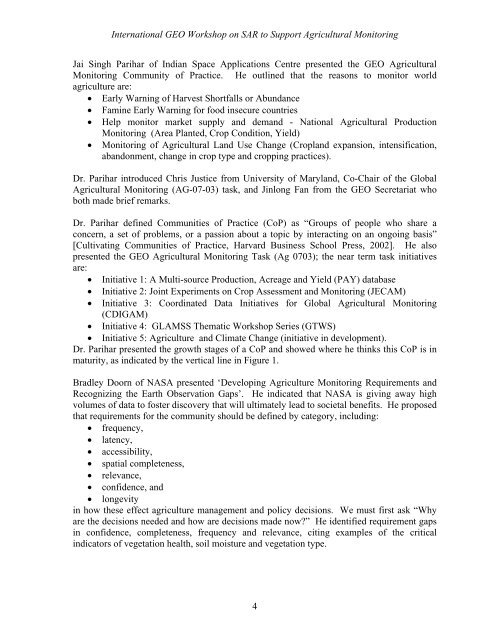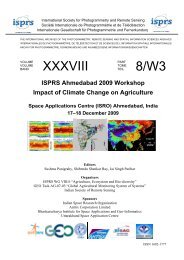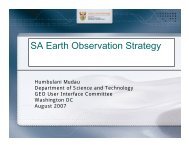(SAR) to Support Agricultural Monitoring 2 - Group on Earth ...
(SAR) to Support Agricultural Monitoring 2 - Group on Earth ...
(SAR) to Support Agricultural Monitoring 2 - Group on Earth ...
You also want an ePaper? Increase the reach of your titles
YUMPU automatically turns print PDFs into web optimized ePapers that Google loves.
Internati<strong>on</strong>al GEO Workshop <strong>on</strong> <str<strong>on</strong>g>SAR</str<strong>on</strong>g> <str<strong>on</strong>g>to</str<strong>on</strong>g> <str<strong>on</strong>g>Support</str<strong>on</strong>g> <str<strong>on</strong>g>Agricultural</str<strong>on</strong>g> M<strong>on</strong>i<str<strong>on</strong>g>to</str<strong>on</strong>g>ring<br />
Jai Singh Parihar of Indian Space Applicati<strong>on</strong>s Centre presented the GEO <str<strong>on</strong>g>Agricultural</str<strong>on</strong>g><br />
M<strong>on</strong>i<str<strong>on</strong>g>to</str<strong>on</strong>g>ring Community of Practice. He outlined that the reas<strong>on</strong>s <str<strong>on</strong>g>to</str<strong>on</strong>g> m<strong>on</strong>i<str<strong>on</strong>g>to</str<strong>on</strong>g>r world<br />
agriculture are:<br />
• Early Warning of Harvest Shortfalls or Abundance<br />
• Famine Early Warning for food insecure countries<br />
• Help m<strong>on</strong>i<str<strong>on</strong>g>to</str<strong>on</strong>g>r market supply and demand - Nati<strong>on</strong>al <str<strong>on</strong>g>Agricultural</str<strong>on</strong>g> Producti<strong>on</strong><br />
M<strong>on</strong>i<str<strong>on</strong>g>to</str<strong>on</strong>g>ring (Area Planted, Crop C<strong>on</strong>diti<strong>on</strong>, Yield)<br />
• M<strong>on</strong>i<str<strong>on</strong>g>to</str<strong>on</strong>g>ring of <str<strong>on</strong>g>Agricultural</str<strong>on</strong>g> Land Use Change (Cropland expansi<strong>on</strong>, intensificati<strong>on</strong>,<br />
aband<strong>on</strong>ment, change in crop type and cropping practices).<br />
Dr. Parihar introduced Chris Justice from University of Maryland, Co-Chair of the Global<br />
<str<strong>on</strong>g>Agricultural</str<strong>on</strong>g> M<strong>on</strong>i<str<strong>on</strong>g>to</str<strong>on</strong>g>ring (AG-07-03) task, and Jinl<strong>on</strong>g Fan from the GEO Secretariat who<br />
both made brief remarks.<br />
Dr. Parihar defined Communities of Practice (CoP) as “<str<strong>on</strong>g>Group</str<strong>on</strong>g>s of people who share a<br />
c<strong>on</strong>cern, a set of problems, or a passi<strong>on</strong> about a <str<strong>on</strong>g>to</str<strong>on</strong>g>pic by interacting <strong>on</strong> an <strong>on</strong>going basis”<br />
[Cultivating Communities of Practice, Harvard Business School Press, 2002]. He also<br />
presented the GEO <str<strong>on</strong>g>Agricultural</str<strong>on</strong>g> M<strong>on</strong>i<str<strong>on</strong>g>to</str<strong>on</strong>g>ring Task (Ag 0703); the near term task initiatives<br />
are:<br />
• Initiative 1: A Multi-source Producti<strong>on</strong>, Acreage and Yield (PAY) database<br />
• Initiative 2: Joint Experiments <strong>on</strong> Crop Assessment and M<strong>on</strong>i<str<strong>on</strong>g>to</str<strong>on</strong>g>ring (JECAM)<br />
• Initiative 3: Coordinated Data Initiatives for Global <str<strong>on</strong>g>Agricultural</str<strong>on</strong>g> M<strong>on</strong>i<str<strong>on</strong>g>to</str<strong>on</strong>g>ring<br />
(CDIGAM)<br />
• Initiative 4: GLAMSS Thematic Workshop Series (GTWS)<br />
• Initiative 5: Agriculture and Climate Change (initiative in development).<br />
Dr. Parihar presented the growth stages of a CoP and showed where he thinks this CoP is in<br />
maturity, as indicated by the vertical line in Figure 1.<br />
Bradley Doorn of NASA presented ‘Developing Agriculture M<strong>on</strong>i<str<strong>on</strong>g>to</str<strong>on</strong>g>ring Requirements and<br />
Recognizing the <strong>Earth</strong> Observati<strong>on</strong> Gaps’. He indicated that NASA is giving away high<br />
volumes of data <str<strong>on</strong>g>to</str<strong>on</strong>g> foster discovery that will ultimately lead <str<strong>on</strong>g>to</str<strong>on</strong>g> societal benefits. He proposed<br />
that requirements for the community should be defined by category, including:<br />
• frequency,<br />
• latency,<br />
• accessibility,<br />
• spatial completeness,<br />
• relevance,<br />
• c<strong>on</strong>fidence, and<br />
• l<strong>on</strong>gevity<br />
in how these effect agriculture management and policy decisi<strong>on</strong>s. We must first ask “Why<br />
are the decisi<strong>on</strong>s needed and how are decisi<strong>on</strong>s made now?” He identified requirement gaps<br />
in c<strong>on</strong>fidence, completeness, frequency and relevance, citing examples of the critical<br />
indica<str<strong>on</strong>g>to</str<strong>on</strong>g>rs of vegetati<strong>on</strong> health, soil moisture and vegetati<strong>on</strong> type.<br />
4







